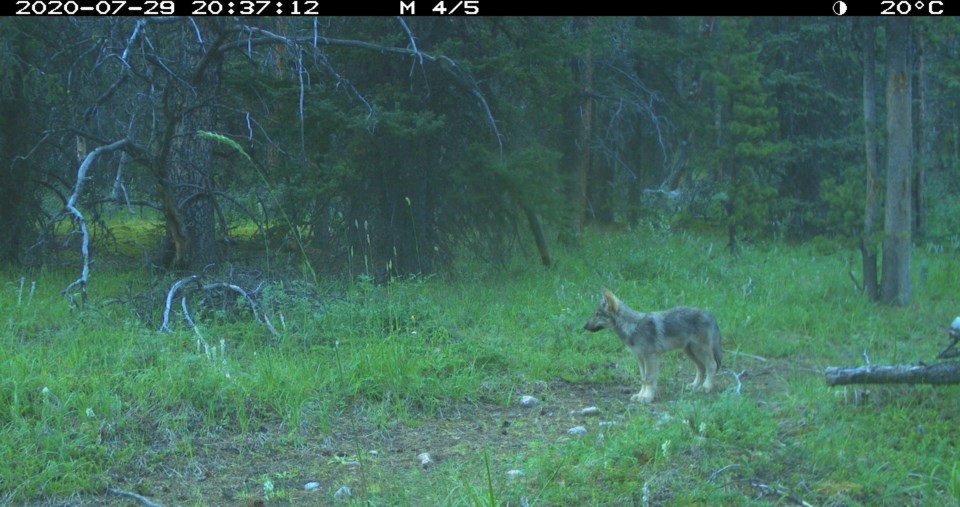BANFF – An injured wolf pup from the Bow Valley pack seems to be faring well in the wild.
One of the pups born to the pack this spring was first reported injured in mid-October in the Minnewanka Loop, prompting Parks Canada’s wildlife team to investigate immediately.
Wildlife experts say the black-coloured wolf pup appeared to be in fairly poor condition, with an injured back leg making it hard for the animal to move, and its future seeming “fairly disconcerting.”
“Fast forward two-and-a-half months and it’s making use of three legs and has been able to move and keep up with the pack,” said Dan Rafla, a human-wildlife coexistence specialist with Banff National Park.
“In terms of a full recovery, it’s unlikely, but the pack is looking after this wolf and as long as that continues to happen, this wolf will probably likely continue to live.”
It is not known for sure what caused the wolf pup’s injuries.
Parks Canada suspects it was either struck by a vehicle, although there were no reports of that to Banff dispatch, or that it was hurt when the pack was hunting elk in the area.
Rafla said there was a bachelor herd of elk in the area at the same time the wolf pup was observed with its injuries, and so it’s not unreasonable to assume it may have been hurt by an elk.
“It might have gotten too close to the elk, or maybe in an attempt with the pack to hunt those elk,” he said.
“One of them could have defended itself and that pup wasn’t able to get out of the way in time of a hoof or an antler.”
Wolves do live fairly tough existences, even when they live long and healthy lives.
“Often upon their natural death, when necropsies are performed, you do see the results of injuries from their lives … broken bones that have fused and some pretty significant injuries,” Rafla said.
With that in mind, Parks Canada made a deliberate decision not to intervene in this wolf pup’s life, particularly if it was injured under natural circumstances.
“Some of these are sometimes difficult to experience or see, but we can’t intercede because this is the natural world,” Rafla said, noting part of Parks Canada’s mandate is to let natural processes occur.
“The other side, which in this case is quite interesting, is to see the wolf behaviour of the pack looking after its members. If they weren’t, this wolf would unlikely be here today.”
It is important that people give this injured wolf the space needed to go about its life – and Parks Canada warns against illegally feeding it because that could lead to a poor outcome for this animal.
“Right now, the wolf is able to move and is being fed presumably by members of its pack,” Rafla said. “But if ever that situation were to change, and people who are feeling bad for the wolf and maybe think it’s a good idea to feed it, that would likely lead to a negative outcome for this wolf.”
The Bow Valley wolf pack is believed to have about seven or eight members. The female wolf, known as No. 1701, is fitted with a conventional VHF collar, and a two-and-a-half-year old male wolf, No. 2001, wears a GPS collar.
The young male wolf has been making forays into the Canmore region this year, including east to Gap Lake and the lower slopes of Pigeon Mountain.
“He is still with the pack, which is interesting,” Rafla said.
“Typically these wolves (in this age group) begin to consider their own territory and that may still happen.”
Wolf 2001 would likely have helped with the hunt and feeding of the pups this year, especially considering the breeding male of the pack, known as 1901, was killed on the Trans-Canada Highway about 1.5 kilometres west of Banff in May.
“Particularly because we lost 1901 in the spring, just a couple of months after the pups would have been born, other pack members certainly would have helped to have fed the next generation of wolves,” Rafla said.
It is believed the breeding male got onto the Trans-Canada Highway by crossing a cattle guard at one of the interchanges – considered one of the weak spots in the system of wildlife crossings and wildlife exclusion fencing.
Rafla suspects another male wolf will step in and take the place of the breeding male, if it hasn’t already happened.
“We think there’s probably a good chance at this stage there may be an alpha male possibly that has joined this pack,” he said.
“We don’t know for certain, but it would be just a matter of time before that would happen.”
Rafla said this most recent incident involving the injured wolf pup speaks to the importance of visitors and residents reporting carnivore sightings or incidents, noting it was a member of the public who alerted them of the hurt pup.
“It certainly helped us to assess if the wolf was getting better or getting worse,” he said. “In this case, it did seem this wolf was able to move a little bit better each day.”
Carnivore observations can be reported to Banff Dispatch at 403-762-1470.
“At this time of year and through winter, we do tend to see wolves and other carnivores like cougars that may be observed a little more frequently,” Rafla said.
“That’s just because the density of their prey – elk and deer – is a bit closer to the townsites and in the valley bottom as winter settles in.”




